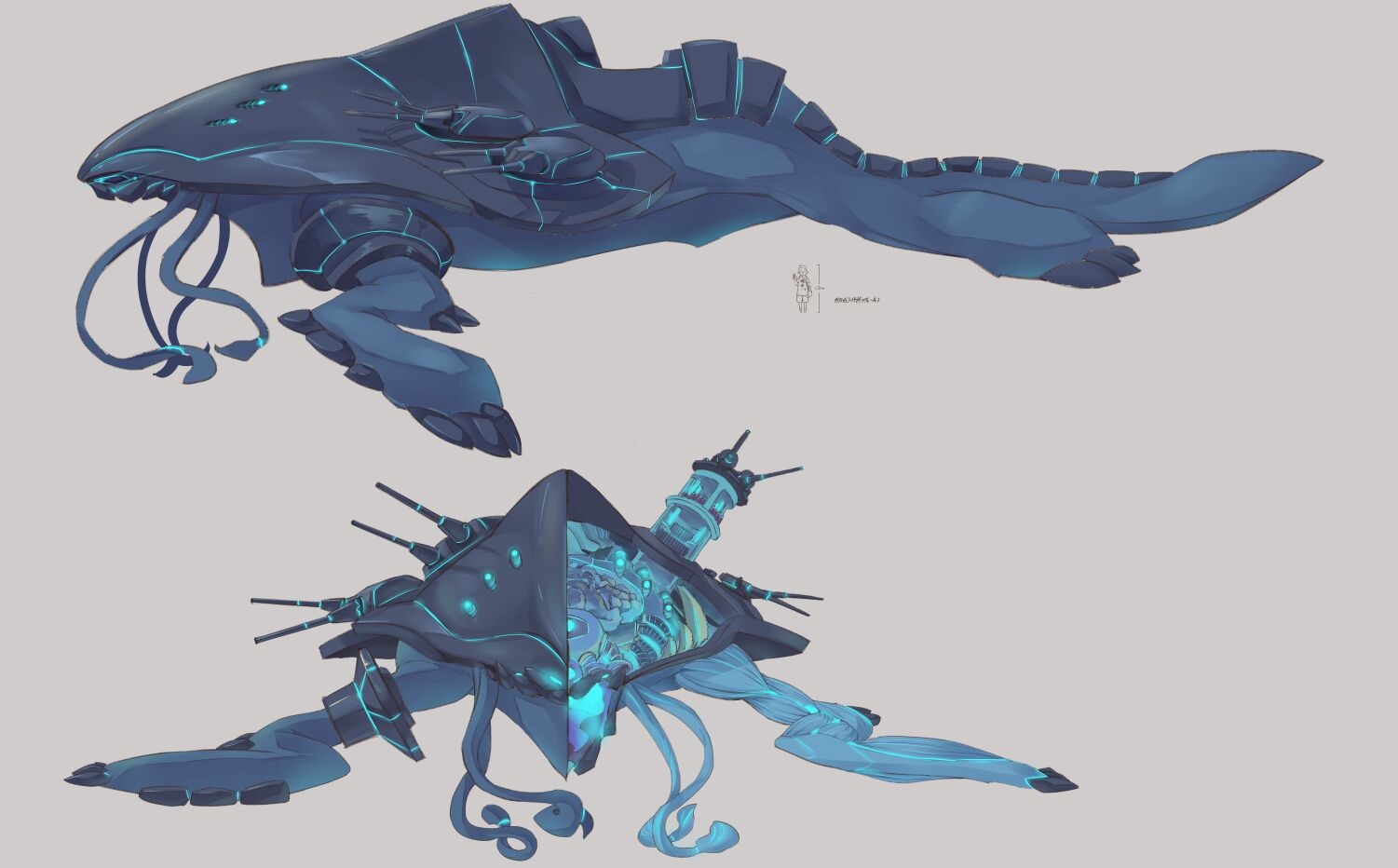STEC Archives, Print Document Division
Curator signature: Cusk
Excerpt (Abstract) From Special Collection #45 – Abyssal Research

Overview:
The Abyssal in question was encountered and neutralized during routine Anti-Abyssal efforts on March 15th, 1989 near Zone 71 (Northern Scotland, near the Island of Hermaness) in coordination with RN-STEC’s Home Fleet Command. The unusual method in which the Abyssal was dispatched by a combination of direct gunfire from Narwhal after suffering a (what is presumably fatal) blow from Edda resulted in an injury pattern conducive to data generation on the MORGAN II platform, which was reconstructed on NAB Avalon post encounter.
Description:
Conceptualized in 1985, The MORGAN II is a miniaturized support system currently in Field Trial Phase III created under the direction of Cmdr. Michael Yin. Its purpose is to offer a rapid, systematic integration of incoming signals from various primary data gathering instruments native to shipgirl equipment, particularly in situations where access to the MERLIN network or similar STEC supporting networks are limited due to natural or artificial interference. The device is scheduled to be integrated into all subgirl equipment by early 1990.
Building on the experiences of its predecessor, the current iteration of MORGAN applies similar technology to that of its distant cousin, the MERLIN series reconnaissance satellites currently in orbital deployment. The most prominent improvement is the capacity to carry out on-field post-hoc data-noise complexity reduction, which enables the shipgirl in question to rapidly pinpoint and integrate, in real time, the physical location and properties of an Abyssal opponent in question based on bioelectrical pattern analysis.
Under normal operational circumstances, the MORGAN II is a self-sufficient system which requires no additional input or support from its shipgirl. Narwhal’s active manipulation of its internal parameters resulted in a “compounding” of the dataset generated, where the varying intensities of bioelectrical signals obtained as a result of Abyssal feedback was able to create something functionally similar to a biopsy (at least on a superficial level). Given the inherent challenges in understanding Abyssal physiology due to the limitations placed on both researchers and the nature of the opponent, the dataset obtained is of significant application.
Details:
The Abyssal form in question is consistent with the “scout” designation, albeit unlike many of its counterparts appears to be heavily armored relative to prior encounters. Following typical anti-Abyssal doctrine, Narwhal fired with her primary armaments at the limit of known engagement, scoring eight (8) out of eleven (11) shots fired.
Upon impact of the first shell, the Abyssal made no efforts to submerge, but instead chose to “turn” towards Narwhal and advance, facing its heavily armored hulk directly towards the direction of incoming fire. Typical of Abyssal behavior, it fired several coordinated volleys from its main “turrets” in an attempt to gauge the location of Narwhal, who by then have already submerged and relocated.
At this point, the RN-STEC shipgirl “Edda” entered the skirmish from approximately due north relative to the Abyssal’s current location, firing a series of ten (10) heavy HE shells towards the Abyssal. Unable to react in time, the Abyssal’s entire left side was immediately “vaporized.” In the seconds that followed, the RN-STEC shipgirl closed the gap and attacked the Abyssal in melee combat, scoring in short time several long strokes along its “torso” and knocking it onto its ventral axis, upon which the Abyssal appears to cease its movements. A short time after, the Abyssal’s “corpse” dissipated as typical.
Summary of key findings:
Narwhal’s MORGAN II system reveals the following (data attached as part of appendix):
- If sufficiently high resolution, the level of bioelectrical activity is a good metric of Abyssal activities.
- Fine-turning the data collected would enable a much more robust way to track Abyssal activity on the battlefield and provide an additional source of “eyes” for all shipgirls.
- Abyssal defense strategies are complex, and revision of terminology may be required in the future. Specifically, “regeneration,” while more commonly understood, is likely to be an inaccurate description of the phenomena in which the Abyssals appears to “regrow” its body parts or components. Analysis of Narwhal’s MORGAN II data seems to suggest that the phenomena appears to be more similar to scar tissue generation, where segments and components of the Abyssal appears to be explicitly allocated for the purpose of rapidly “forming” a hardened substance speculated to be of similar composition to the typical Abyssal physical defenses. Due to the extraordinarily differences in density, pattern, and property of the bioelectrical signals extruded, it is very plausible that the restoration of form is not connected to function – in other words, more similar to damage control rather than straight-up “healing,” at least to our understanding.
- Based on this new encounter, it appears that Abyssals do indeed possess internal “ammo” stockpile equivalents. However, the differences may be due to the limitations within the MORGAN platform, and it is plausible that the Abyssals possess a fluid amount of material used to “construct” shells necessary to its operations on the field.
- The incident provides key data that may help elucidate the nature of the Abyssal threat. It is now plausible to assume that the Abyssal is some sort of cybernetic organism rather than a purely biological or organic entity.
Prospectus: While we have traditionally considered the Abyssal to be an opponent shrouded in complete mystery, this encounter represents an opportunity to further improve and refine our own capabilities. The development of other combat accessories that serve similar functions to MORGAN, or even MORGAN itself, should be given significant consideration given that the understanding of the Abyssal opponent is a high priority for STEC.
